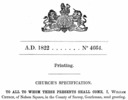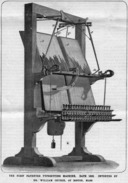In 1822, Dr. William Church, an American living in England, patented a trio of machines which operated together as a system: a typecasting machine, a typesetting machine, and an improved platen printing press. The typesetting machine is very important historically because it seems to have been the first patented composing machine. Whether Church's typecasting machine was the first depends a lot on what you mean by "machine." Certainly it was plausible, though (as Huss argues) it probably couldn't have worked well as proposed. (The flaw isn't in the mechanical design as such but in its inadequate heating arrangements.)
Church's inventions, while commercially unsuccessful, are perhaps most important for introducing what Huss calls "Church's Law." This is the principle of "non-distribution": that given a sufficiently good typecasting machine it is easier and cheaper to cast new type for each use than to "distribute" type back to typecases to be re-used. The three machines with which Church proposed to do this constituted an entire system for making, setting, and using type. This principles (expressed in much different forms, of course) was a part of the two successful composing machine systems which dominated later work, the Linotype and the Monotype.
Church's typesetter suffered from one shortcoming which would prove most difficult for later attempts: it could not justify lines.
Note: Dr. Church's inventions span categories - a typesetter, a typecaster, and various printing presses and improvments on presses. As such it would make sense to consider each in its proper section of these Notebooks. Yet at the same time the 1822 typecaster/typesetter/prss system joined categories, so they can't really be split apart. In the interest of simplicity, I'll group all of my Notebooks on Dr. Church in one place, here. (This happens to be in the typecasting section, because I became interested most deeply in his typecaster before his typesetter or presses.)
Title: "An Improved Apparatus for Printing." Patentee: William Church. Date: [The Specification as reprinted in 1857 gives the date as March 21, 1822. The report in The London Journal of Arts and Sciences Vol. 6, No. 25 (1823): 225 says "Sealed 21st March 1822." However, the Abridgment of the Specification printed in 1859 gives the date as March 24, 1822.] Date Inrolled: Sept. 21, 1822.
Note: A search of their online catalog suggests that the US Library of Congress does not possess copies of the Specifications for (British) Patents for Inventions. (This is a shame, since the Library of Congress is exemplary in not imposing its own restrictions on copies it makes of public domain materials.) It does possess several of the volumes of Abridgments.

Richard E. Huss
Huss' book Dr. Church's "Hoax" is the definitive study. However, while it contain reproductions of all three of the Scientific American (1903) illustrations of Church's machines, it contains only a subset of the original patent drawings (just one drawing one per machine).
See the "Other Patents" group later in this Notebook for references to Church's patent No. 4,903 of 1824 (which improved the Press of the 1822 system) and No. 5,417 of 1926 (which again improved the Press).

1822 Specification, As Inrolled
This is the only truly primary source. Unfortunately, it is very difficult (at least for an American) to obtain. I have yet to see it, or even a photographic copy of it. If you purchase a copy from the UK Intellectual Property Office you do not receive a copy of the actual enrolled patent specification but instead a copy of the version printed in 1857 by Eyre and Spottiswoode (with black and white copies of the original colored drawings, drawn "on stone" by Malby and Sons).

1822 Specification, British Library Copy
[NEED TO OBTAIN] [Note however that the British Library imposes restrictions on the reproductions of copies it makes, even of public domain materials, so I may not be able to show anything here even if/when I do obtain it.]

1822 Specification, NYPL Copy
After not inconsiderable expense, I finally obtained copies of these. Regrettably, the NYPL seems able only to supply inferior copies (and that only when asked very specifically, and after explaining their own catalog entries to them). Further, the NYPL imposes by contract restrictions on these copies, prohibiting their reproduction (even though they are copies of public domain material). This exercise was useful, however, insofar as it enabled me to ascertain that the NYPL version is indeed the 1857 printing (which I have been able to reproduce from a UK Intellectual Property Office copy; see below).

1822 Specification, As Printed in 1857, UK IPO
If you purchase a copy of the patent from the UK Intellectual Property Office, you receive a photocopy of this 1857 printing by Eyre and Spottiswoode. The drawings as printed were (re)drawn (by hand) "on stone" by Malby and Sons as black and white line drawings (with a note indicating that the originals were colored), and the text was of course re-set by hand. This is thus at least one generation removed from the original (or more, since the phtoocopy is illegible in many places in ways which suggest that it might not in fact have been made directly from the 1857 printing).

1822 Specification, as Reported in The London Journal of Arts and Sciences ("Newton's)
The drawings in this were hand-drawn copies from the enrolled originals, and thus while not official copies are at the same generation of removal from the original as the 1857 official printing. They are, however, incomplete - there are drawings present in at least the 1857 official printing by Eyre and Spottiswoode (and presumably therefore also in the Inrolled Specification) which are not present in the London Journal. Also, the only readily available copies of this Journal are those available through Google Books, and the resolution of these digitizations is not sufficient to show the details of the machines.

Scientific American, 1903
This has the most beautiful pictures. Regrettably, they are inaccurate.

Hansard, Typographia
[NOT DONE] Hansard. Typographia. 1825 (Google, Mich. copy) p. 665-677. Cites London Journal of Arts and Sciences

The Monthly Magazine
[NOT DONE] No. 382 (5 of Vol. 55, June 1, 1823): 453. A one-page summary, without illustrations; claims a company to be set up in New York.
The Franklin Journal and American Mechanics' Magazine [later the Journal of the Franklin Institute] Series 1, Volume 1, No. 3 (March 1826)): 150-151 [Google PDF pp. 163-164] contains a copy of the report in The London Journal of Arts and Sciences.

The 1822 Patent, Annotated (Typecaster)
[NOT DONE] Working through the typecaster portion of the 1822 patent, illustrating it inline with fragments from the patent diagrams and other sources.

1823, No. 4,760 - Block and Plate Printing
[JUST BIBLIO FOR NOW] For apparatus for block and plate printers "particularly to the printing of calicoes, linens, silks and other fabrics". This is a cylinder press employing "radial" type (that is, type curved to conform to a cylinder).

1824, No. 4,903 - Press
[JUST BIBLIO FOR NOW] The London Journal of Arts and Sciences (1825) cites this as an improvement on the Press of the 1822 system.

1826, No. 5,417
[JUST BIBLIO FOR NOW] Both he The London Journal of Arts and Sciences (1828) and the 1859 Abridgment cite this as a further improvement on No. 4,903 of 1824, intself an improvement upon the Press of the 1822 system.

1850, No. 12,994 - Press
[JUST BIBLIO FOR NOW] Paper or pasteboard cards
Huss cites many non-printing inventions of Church as well. Of these, a few seem relevant to typecasting:

1824, Casting Metals
[NOT DONE] Prosser, Richard B. Birmingham Inventors and Inventiosn. 1881. Reprinted, Wakefield, UK: S. R. Publishers, 1970, p. 203. But "no details" in that source.

1825, Casting Rolls, Pipes, Etc.
[NOT DONE] Prosser, Richard B. Birmingham Inventors and Inventiosn. 1881. Reprinted, Wakefield, UK: S. R. Publishers, 1970, p. 184. Vacuum in mold, and compressed air to force metal in. The use of the term "Improvements" suggest to me that there might have been a patent associated with this.
All portions of this document not noted otherwise are Copyright © 2008-2010 by David M. MacMillan and Rollande Krandall.
Circuitous Root is a Registered Trademark of David M. MacMillan and Rollande Krandall.
This work is licensed under the Creative Commons "Attribution - ShareAlike" license. See http://creativecommons.org/licenses/by-sa/3.0/ for its terms.
Presented originally by Circuitous Root®
Select Resolution: 0 [other resolutions temporarily disabled due to lack of disk space]